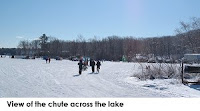 Recently I was fortunate enough to be tapped to engineer a live remote in the snowy reaches of Camden, Maine. The folks at American Public Media’s Weekend America wanted to cover the US National Tobogganing Championship, so they sent intrepid reporter Keith O'Brien to cover the fierce, yet admittedly whimsical, competition.
Recently I was fortunate enough to be tapped to engineer a live remote in the snowy reaches of Camden, Maine. The folks at American Public Media’s Weekend America wanted to cover the US National Tobogganing Championship, so they sent intrepid reporter Keith O'Brien to cover the fierce, yet admittedly whimsical, competition. Keith went up a week before the event to get a lay of the land and interview several competitors. He put together a fine pre-recorded piece and sent it off to the
Keith went up a week before the event to get a lay of the land and interview several competitors. He put together a fine pre-recorded piece and sent it off to the This presented something of a problem, as about half the toboggan chute extends out over the frozen expanse of Hosmer Pond. There’s no AC power out there, nor any telecommunications landlines. There was a cellphone tower not far away, with good line of sight…but for a nationally-distributed public radio show, we wanted better audio quality than a regular cellphone would deliver. And there wasn’t time to get a POTS-codec up there for testing. So we needed something that was known to work, and could work completely independent of any existing infrastructure in Camden. That meant satellite! Specifically, ISDN over satellite. With the right satphone, you can establish a 64kbps channel, which is more than sufficient for a decent quality ISDN connection.
 Now as you might imagine, there’s about a thousand things that could go wrong with this setup. And go wrong they did! It was a comedy of errors for practically the entire process. But with foresight, planning, backups, testing, more backups, more testing and yet more backups, we kept it a comedy rather than a tragedy.
Now as you might imagine, there’s about a thousand things that could go wrong with this setup. And go wrong they did! It was a comedy of errors for practically the entire process. But with foresight, planning, backups, testing, more backups, more testing and yet more backups, we kept it a comedy rather than a tragedy.Keith’s initial visit had us pretty confident that we’d have a good view of the sky for the satellite. But first we had to make sure the equipment survived shipping to me in
 Our first test was from my apartment in
Our first test was from my apartment in After much fiddling with the satellite dish, I discovered that you must aim the dish very precisely, but you’ll get four or five bars of signal as a reward. The dish has a built-in gimbaled compass that helps, but it’s mostly done by a steady hand and lots of little changes. It was very difficult as the dish isn’t designed to hold anything but a 0, 45 or 90 degree tilt. Anything else required external bracing to hold it steady. Still, once the proper aim was achieved, we got a solid lock on both ends, and our ISDN’s were very happy.
I retired to my hotel room and re-packed all the gear with an eye towards carrying it by hand if I couldn’t get my preferred parking spot. All batteries were topped off and I nodded off for the evening, hoping the weather would clear.
 Fortune smiled on us, as day came with beautiful clear skies, a fresh layer of ice on the chute, and plunging temperatures. Good thing I packed extra sweaters and long underwear! I met with Keith and, after some arguing with the parking guards, was able to get my car situated in the same spot where I did my test, and got everything set up. Except I realized that the UPS that had initially provided a perfectly-sufficient 25 minutes of power, was not providing jack squat! I had left it charging for two days, it should’ve been fine…but later tests showed it just refused to take a charge at all. Perhaps the stress test damaged the battery. Regardless, it's good thing we had a spare UPS. And as it turns out, despite valid concerns about an inverter’s “square wave” causing audible noise on the ISDN, there wasn’t any noise and we just ran on the inverter alone.
Fortune smiled on us, as day came with beautiful clear skies, a fresh layer of ice on the chute, and plunging temperatures. Good thing I packed extra sweaters and long underwear! I met with Keith and, after some arguing with the parking guards, was able to get my car situated in the same spot where I did my test, and got everything set up. Except I realized that the UPS that had initially provided a perfectly-sufficient 25 minutes of power, was not providing jack squat! I had left it charging for two days, it should’ve been fine…but later tests showed it just refused to take a charge at all. Perhaps the stress test damaged the battery. Regardless, it's good thing we had a spare UPS. And as it turns out, despite valid concerns about an inverter’s “square wave” causing audible noise on the ISDN, there wasn’t any noise and we just ran on the inverter alone. Then not an hour later, a dogsled team with ten noisy huskies set up shop not 20 feet from us! Trust me, it's still a comedy! A little chat with the owners and they said it'd be no problem to take the dogs on a run across the frozen lake when we were actually live...which actually worked great from an ambient sound perspective.
Then not an hour later, a dogsled team with ten noisy huskies set up shop not 20 feet from us! Trust me, it's still a comedy! A little chat with the owners and they said it'd be no problem to take the dogs on a run across the frozen lake when we were actually live...which actually worked great from an ambient sound perspective. After both I, and Keith’s wife, remarked how amazing it was that nobody had died on that toboggan chute…Keith took the plunge with the chutemaster during a break in the trials. He says for most of the nine seconds, he didn’t scream because he couldn’t breathe. But when he found his breath...well, I think I heard him from across the lake! And let’s just say his choice in words wasn't FCC-friendly! Afterwards, Keith met up with competitor Andy Hazen, who was to be interviewed live at about
After both I, and Keith’s wife, remarked how amazing it was that nobody had died on that toboggan chute…Keith took the plunge with the chutemaster during a break in the trials. He says for most of the nine seconds, he didn’t scream because he couldn’t breathe. But when he found his breath...well, I think I heard him from across the lake! And let’s just say his choice in words wasn't FCC-friendly! Afterwards, Keith met up with competitor Andy Hazen, who was to be interviewed live at about  Feeling a little nervous but nonetheless hopeful,
Feeling a little nervous but nonetheless hopeful,
The ultimate point here is that pretty much everything that could go wrong, did. Even comically so; my polarized sunglasses – ideal for snow glare – made reading all the LCD displays very difficult. Fortunately we figured out most of what could go wrong in advance and had time to prepare backups. In fact, the one thing we didn't test to real-world conditions was the one thing we were nearly bitten by: the battery life of the satphone. Admittedly there was little reason to test it beyond a minute or two; satphone calls run around $5/minute (ouch!) and we had every reason to expect that two batteries would be more than sufficient, or that we could run off charger if we had to. Everything had at least one, if not two levels of backup…but that was one area we needed three.
So what’s the moral? Test, test, test! Always do tests as if they were the real thing; never assume something will work as you expect it to, and always have at least one solid backup to every part of your system (extra UPS’s and the inverter, extra batteries), and a separate backup that’s completely separate and redundant to everything (Keith’s cellphone).
In conclusion, I’m not sure I’d recommend this method for doing remote recordings. It’s got several potential points of failure and is prohibitively expensive. A cynical observer might remark that Keith could've made one trip with a portable flash or minidisc recoder, edited the piece, and filed it for the following week's show.
But at the same time, that's not really what Weekend America is about. I'm told the show strives to have a "live" feel to it and it definitely contributes to its overall "sound" every week. Plus who wants to hear about the toboggan championships that happened last week?? It sounds a lot better when you're talking about something happening this weekend!
So with that kind of mandate in mind, it's good to know that you've got options like ISDN-over-satellite in your toolbox. Plus I got paid to have a fun trip to Maine and watch guys hurtle down a chute on an old couch. Ain't public radio grand?!? :-)
Photo Credits: Weekend America, Keith O'Brien & Aaron Read

No comments:
Post a Comment